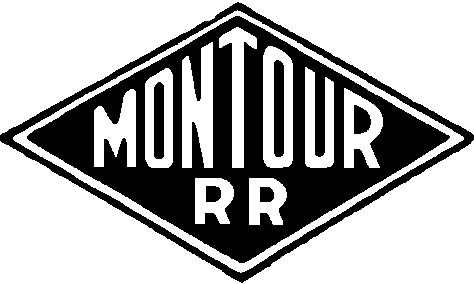 Montour Railroad
Montour Railroad 
|
|
National No. 3 at Muse Read Bob Ciminels' full report on the National No. 3 Mine. Although
National No. 3 closed in 1955, the tracks that formerly served the mine
stayed in operation until the Montour was abandoned. Chemical
& Solvents Company had a facility on the old mine property that
received both box cars and tank cars. Continuing eastward past Cowden Siding, we come to Muse Junction and the Muse Spur, built in 1921 to serve the National Mining Company’s National No. 3 Mine (National Mining was a subsidiary of the United States Steel Company). National Mining owned and operated National No. 3 until December 29, 1942 when the deed was transferred to the H. C. Frick Coke Company, which operated the mine until at least 1947. When the mine closed in 1955 it was owned by U.S. Steel, but when it was transferred from Frick to USS is not known. - Bob Ciminel
National No. 3 was almost on top of the Cross Creek Syncline. Coal depth was 840 to 920 MSL, surface around 1,100 MSL. Mine was almost 200 feet down.
A Visit to National No. 3 There are a
couple of buildings right beside where the loading tipple was, but we
cannot find anything that shows they were part of the mine. They are
not on the Penn Pilot photos, but can be seen on the current Google
satellite. Where the Chemical Company was, were the offices, mule barn,
supply sheds and I think an entrance into the mine. Nothing is left in
that area now, except one pile of dirt with a fence around it.
Something nasty buried there, I'm sure....I had one person in Muse tell
me that there may have been another business use the tipple area after
the mine was gone, but haven't been able to find anything about it.
This steel
building is about 100 feet from the tipple, up on a hill, but we cannot
find any indication of a railroad going to that location. There were a
couple of spikes and ties in the area, but who knows???? Behind it is
the remains of a concrete block building and about 50 feet behind that,
down a bank, is a concrete wall that I believe was part of the mine
tipple. There are indications of railroad tracks by the
concrete wall.
This looks a lot
like an engine service facility, but don't have a clue why it is there.
(Bailey is not sure either, but he was checking it out.) It
would be one thing if there was something on the old mine pictures that
is now gone, but these do not show on any mine pictures and are now
still sitting there. They must have been built after the mine, but
why??? And by whom??? There was a bath house next to the tipple, but I
was told it was built of red brick - as were all of the mine buildings.
The concrete block building had no windows or interior plumbing that we could find. Not even electrical conduit on any of the walls. Concrete floor with a big door on one end and a side door or 2 is it. Perhaps a garage or storage building? It is about 24x48 - the steel building probably 20x100. Check the picture on page 60 in Gene's book. The concrete block building is about where the brick building (bathhouse) is sitting up behind the tipple. Everything is grown up in brush, trees and jagger bushes and the bank itself is different, perhaps when the tipple was razed and regraded. Also, there is a steel structure that looks like the part of the tipple over the tracks loadi .
However, it is located about 400 feet north of the concrete wall and
the tipple site. It does have ties leading right under it, but it is in
the "wrong" place....... It seems to be near to where the switch would
have been to go over to the Chemical Co/mine office
area. Anyone?? Anyone?? More mysteries.
That is what makes it fun to explore. Oh by the way- a story told to me - there were 2 sets of mules used to work in the mine, pulling the mine cars. One set was kept in the mine and the other outside in the barn. They were rotated, but perhaps only once a month. From working in the dark mine all the time, the mules were blind. I have a couple of other names of "old-timers" that were around when the mine was open, and will try to contact them for any info or pictures.
There
was a safety recognition award for National No. 3. The mine
operated between August 31, 1932 and January 1, 1935 without a fatal
accident. It produced 1,695,814 tons of coal over that period
using 2,509,080 man-hours of work, 40% of which involved pillar
extractions, the most dangerous form of mining. The coal seam at
No. 3 was between 60 and 66 inches thick.
|